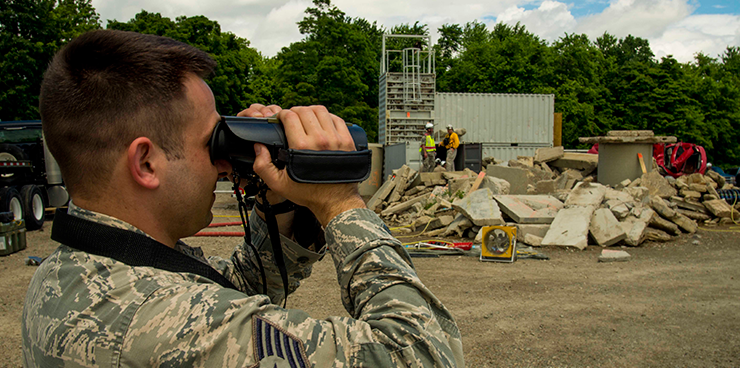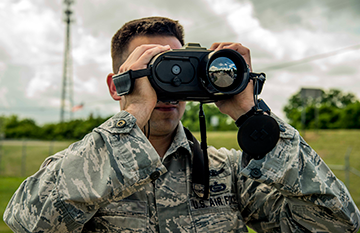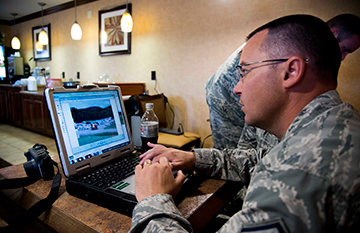Ohio National Guard News
Getting smart on disaster reliefStory and Photos by Staff Sgt. George B. Davis, Ohio National Guard Public AffairsView Videos |
|
|
|
| Analysts with the 178th Wing’s Information Analysis and Assessment Team capture and analyze imagery during the Guardian Shield ’15 exercise June 16, 2015, at Camp Sherman Joint Training Center in Chillicothe, Ohio. The IAA team is composed of mobile support teams in the field that coordinate imagery and information acquisition to support civilian incident commanders. | |
GUARDIAN SHIELD '15, Ohio (06-16-15) — A new crisis management resource is being developed to assist civilian first responders in the form of an Incident Awareness and Assessment (IAA) Team, composed of Airmen from the Ohio National Guard’s 178th Wing. The IAA team recently participated in Guardian Shield ’15, a multistate complex catastrophe exercise that focused on the interagency coordination between local county first responders, state and federal crisis management agencies, and National Guard responders. When catastrophe strikes, the local county emergency service providers are the first on scene, establishing incident command posts and designating incident commanders to manage the rescue and relief efforts. State agencies like the Ohio Emergency Management Agency, Incident Management Team and the American Red Cross are mandated to provide assistance to county incident commanders. In addition, the governor can activate the Ohio National Guard to support these civilian first responders. The IAA team provides services as part of the Ohio National Guard’s Defense Support of Civil Authorities and Incident Awareness and Assessment state response mission. “The IAA concept is a rapidly developing capability of the Ohio Air National Guard. The goal of the IAA team is to provide the local incident commander, first responders and emergency management agencies with incident awareness and assessment which can reduce loss of life, loss of property, and help prepare for recovery during emergency situations,” said Capt Matthew, a member of the 178th IAA Reachback Cell. When the IAA Mobile Team is deployed, an initial assessment package is produced by the IAA Reachback Cell, which can include onsite aerial, satellite and thermal imagery, and analysis of those images. The goal is for this package to be produced as early into the incident as possible, affording the incident commander the ability to make informed decisions and enabling the potential for a quicker and more efficient response to the situation. The IAA team is composed of mobile support teams in the field that coordinate imagery and information acquisition while interfacing with the incident commander. Information from these teams is then funneled back to the Reachback Cell, located in Springfield, Ohio, where Airmen employ their skills to analyze imagery of the incident site and incorporate all other available information to help establish a common operating picture. The capability of the Springfield Reachback Cell to process large amounts of data in Springfield mitigates the difficulties of responding to a geographically distant disaster location with a large amount of equipment and exponentially increases a timely response. The 178th IAA’s capabilities can assist with emergency management at locations around the world. “That trade craft gives us a unique capability not housed anywhere else in the National Guard, in the country,” said one Airman (some names have been withheld at the interviewees’ request, for security reasons). “The biggest impact that we hope to have is to be able to shorten the impact of whatever the crisis is; to enable the incident managers to focus their efforts where they will do the most good; to be able to know specifically when and where the help is needed saves money and saves lives,” said Master Sgt. Dale (last name withheld), an IAA Mobile Team member. “A lot of the people that are involved in this mission have experience as first responders or were involved in emergency management type agencies — I was a fireman-paramedic for 20 years as a civilian and was on regional response teams. So we have a good understanding of knowing what their needs are and we can go in with a good package anticipating their needs.” The IAA services are most effective when performed in concert with local, state, and federal agencies. The IAA team relies on civil agencies like the Ohio State Highway Patrol, Civil Air Patrol and the Ohio Emergency Management Task Force One for aerial imagery acquisition and tasking. This imagery, combined with unclassified satellite imagery, provides a common operating picture for the incident commanders and various participating agencies. When called upon, the IAA teams are an invaluable asset, due to the ability to use fused information to potentially reduce response time, reduce further property damage, quicken recovery and ultimately save lives. |
|

